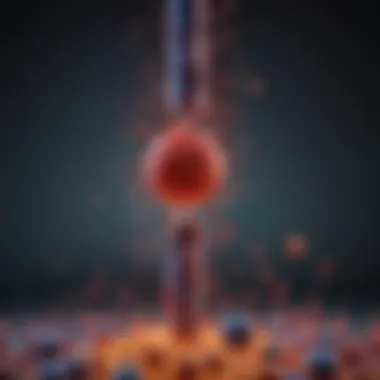BTK Inhibitors: Mechanisms and Future Perspectives


Intro
In recent years, the medical research community has zeroed in on Bruton's Tyrosine Kinase (BTK) inhibitors as a promising avenue for therapeutic advancement. These agents are particularly significant in the realm of treating various malignancies and autoimmune disorders. The growing interest surrounding BTK inhibitors stems from their unique mechanisms of action, which allow for targeted intervention in disease pathways, making them a crucial focus for researchers and professionals alike.
Key Findings
Major Results
Research indicates that BTK plays a pivotal role in B cell receptor signaling, which is essential for the survival and proliferation of B cells. This makes BTK inhibitors particularly effective in combating B cell malignancies such as chronic lymphocytic leukemia. Furthermore, ongoing studies reveal their potential in treating autoimmune diseases like rheumatoid arthritis.
- BTK inhibitors block the receptor signaling process, leading to reduced B cell activity.
- Clinical trials have shown promising responses in patients with varying types of B cell malignancies.
- Emerging data hints at possible applications in other immune-related conditions.
Discussion of Findings
The successful application of BTK inhibitors like Ibrutinib and Acalabrutinib in clinical settings underscores their effectiveness. Publications have demonstrated that not only can these agents halt disease progression, but they can also offer improved patient outcomes. However, their use is not without challenges; the potential for adverse effects and drug resistance remains an area requiring further exploration. Additionally, understanding the long-term implications of BTK inhibition on immune system functions is crucial.
Methodology
Research Design
The methodologies employed in studying BTK inhibitors predominantly encompass both preclinical and clinical research. Preclinical studies often utilize murine models to assess the efficacy and safety of BTK inhibitors prior to human trials. Following this phase, various randomized control trials are designed to better understand their impacts on specific populations suffering from B cell malignancies or autoimmune conditions.
Data Collection Methods
Data collection occurs through a combination of retrospective studies, patient registries, and prospective clinical trials. Information garnered from these methods includes treatment response rates, patient survival data, and quality of life metrics. Leverage of both quantitative and qualitative data is key for comprehensive insights.
With the increasing depth of research in this field, the avenues for future exploration regarding BTK inhibitors are vast. Propelled by promising initial results, future studies can be expected to delve deeper into optimizing treatment regimens and expanding the knowledge on the long-term effects of such treatments. Ultimately, the advancements in BTK inhibitor research hold the potential to transform therapeutic strategies in oncology and immunology.
Prologue to BTK Inhibitors
Bruton's Tyrosine Kinase (BTK) inhibitors have gained prominence in recent years due to their significant contributions in treating various cancers and autoimmune diseases. With an intricate role in B-cell signaling pathways, BTK serves as both a gatekeeper and a facilitator of crucial interactions in immune responses. Hence, understanding BTK inhibitors not only provides insights into novel therapeutic avenues but also highlights their relevance across multiple medical disciplines.
The importance of BTK inhibitors cannot be overstated. As targeted therapies, they bring a level of precision that is often lacking in traditional treatment approaches. It’s crucial to grasp how these inhibitors function at a molecular level and what implications they hold for patient outcomes. Researchers and healthcare providers alike benefit from a thorough comprehension of BTK inhibitors, as it lays the groundwork for better treatment strategies and personalized medicine.
In this section, we will explore the essence of BTK.
Understanding BTK
BTK, or Bruton's Tyrosine Kinase, is a non-receptor tyrosine kinase primarily expressed in B-cells. It plays a pivotal role in the signaling pathways that are activated when B-cell receptors (BCR) bind with antigens. This interaction triggers a cascade of downstream signaling events, leading to B-cell activation, proliferation, and eventually, differentiation into effector or memory B-cells.
Notably, mutations in the BTK gene can cause X-linked agammaglobulinemia, a condition characterized by the absence of functional B-cells, thus shedding light on the importance of BTK in immune system functioning. Moreover, BTK is implicated in critical processes beyond B-cell development, encompassing various immune signaling pathways that continue to be of great interest in research.
The Role of BTK in Cellular Signaling
The role of BTK in cellular signaling is multi-faceted, making it a key player in modulating immune responses. Upon stimulation through the BCR, BTK is phosphorylated and activated, subsequently propagating signals that drive essential cellular activities.
- Cell Growth and Survival: BTK facilitates pathways that promote cell survival, thus ensuring that activated B-cells can proliferate effectively—essential for generating an appropriate immune response.
- Cytokine Production: Its activity influences the production of various cytokines, which are pivotal for immune modulation and communication between cells.
- Regulation of Apoptosis: BTK mediates survival signals that can inhibit apoptosis, allowing B-cells that have undergone activation to persist long enough to mount a sufficient response.
In summary, BTK's role in cellular signaling underlines its therapeutic potential. By inhibiting its activity, researchers can manipulate these pathways, often leading to reduced survival of malignant B-cells and altered immune responses that can benefit patients with both cancers and autoimmune disorders. As we proceed, we will delve deeper into the mechanisms of action of BTK inhibitors, exploring how they affect these vital processes.


Mechanism of Action of BTK Inhibitors
Understanding the mechanisms behind BTK inhibitors is essential for grasping how these substances function at a cellular level. This section delves into the nitty-gritty of how BTK inhibitors offer therapeutic potential, particularly in the arenas of hematological malignancies and autoimmune diseases. By outlining the specific actions of BTK inhibitors, we can better appreciate their advantages and limitations, paving the way for future innovations in medicine.
Inhibition of BTK Activity
Bruton's Tyrosine Kinase (BTK) plays a fundamental role in B-cell receptor signaling. When BTK activity is inhibited, it sets off a chain reaction where signal transduction pathways that would normally lead to proliferation and survival of malignant or autoreactive B cells are interrupted. Think of it this way: inhibiting BTK activity is like taking the steering wheel away from a reckless driver. The vehicle (or in this case, B-cell) simply can’t continue on its destructive path.
Additionally, inhibiting BTK affects other downstream signaling molecules, leading to a myriad of cellular consequences. Research indicates that this can also impact the interaction of B cells with their environment, effectively reducing their survival and functionality. The selective targeting of BTK excels at sparing non-malignant cells, which is critical for preserving normal immune function while curbing disease.
Impact on B-Cell Receptor Signaling
The B-cell receptor (BCR) signaling cascade is vital for B-cell survival and activation, with BTK being a key player in this process. When BTK inhibitors step in, they disrupt the entire signaling pathway initiated by antigen recognition through the BCR. This impairment is significant in cancers like Chronic Lymphocytic Leukemia and Mantle Cell Lymphoma. As the BCR fails to transmit survival signals, the affected B cells undergo apoptosis, or programmed cell death.
"For cancers characterized by unchecked proliferation of B cells, interrupting this signaling pathway can lead to meaningful clinical outcomes."
Many clinical trials have shown a reduction in tumor size and improved patient survival rates when BTK signaling is effectively blocked. However, the extent of BCR signaling inhibition can lead to differing treatment responses depending on the tumor microenvironment and individual patient factors.
Effects on Other Signaling Pathways
While BTK is primarily known for its role in BCR signaling, it also interacts with other critical pathways. Its involvement extends to pathways that regulate cell migration, adhesion, and apoptosis. This tells us that inhibiting BTK isn’t just a one-trick pony. For instance, BTK also contributes to the signaling of other leukocyte receptors, which could result in altered immune responses when inhibited.
Here’s the kicker: the cross-talk between BTK and other pathways may lead to both therapeutic benefits and unintended consequences. Disruption in cellular communication could inadvertently affect the function of T cells, potentially leading to immune system complications or adverse effects. That’s why understanding all facets of BTK’s role is vital for optimizing treatment protocols and ensuring patient safety.
In summary, the mechanisms of BTK inhibitors play a pivotal part in determining how effective these agents can be. It is through their specific inhibitory action on BTK activity, their disruption of BCR signaling, and their interaction with various signaling pathways that clinicians can harness the therapeutic benefits while remaining aware of the challenges ahead.
Clinical Applications of BTK Inhibitors
The exploration of Bruton's Tyrosine Kinase inhibitors in clinical contexts reveals their value in treating a spectrum of diseases, mainly hematological malignancies and autoimmune disorders. BTK inhibitors have transformed the landscape of therapeutic options available to patients with conditions where conventional treatments may fall short. They are being hailed not just for their efficacy but also for their mechanistic specificity, which allows them to target the underlying pathways of disease without broadly affecting healthy cells.
Role in Hematological Malignancies
Chronic Lymphocytic Leukemia
Chronic Lymphocytic Leukemia (CLL) stands out as a primary focus for BTK inhibitors due to its prevalent nature among adult leukemias. This malignancy is characterized by the accumulation of functionally impaired B-cells, leading to an ineffective immune response. BTK plays a crucial role in the survival and proliferation of these B-cells. By harnessing the therapeutic potential of BTK inhibitors, clinicians can effectively target the signaling pathways that contribute to the growth and survival of malignant cells.
The use of BTK inhibitors like Ibrutinib has significantly altered the treatment paradigm for CLL. Patients often experience durable responses, prompting discussions around prolonged survival and quality of life. A unique feature of CLL is its variable clinical course; certain patients might remain asymptomatic for years, while others face rapid progression. Hence, the targeted approach of BTK inhibitors aligns well with the needs of this diverse patient population, making it a particularly beneficial choice for inclusion in this discussion. The transition to targeted therapies not only enhances clinical outcomes but also aligns with the trend towards personalized medicine, adapting treatment according to specific patient needs.
Mantle Cell Lymphoma
Mantle Cell Lymphoma (MCL) presents another striking application for BTK inhibitors. This subtype of non-Hodgkin lymphoma is noted for its aggressive behavior and poor prognosis. One unique feature of MCL is the overexpression of the cyclin D1 gene, which leads to unregulated cell cycle progression. BTK plays a pivotal role in the B-cell receptor (BCR) signaling pathway, crucial for MCL cell survival and proliferation. The inhibition of BTK disrupts this survival signal, lending itself to a therapeutic strategy that addresses the underpinnings of this malignancy.
The distinct biological characteristics of MCL, paired with BTK inhibitors, present a strong rationale for their clinical utility. Initial studies have indicated significant responses even among patients with relapsed or refractory MCL, suggesting that BTK inhibitors could pave the way for more favorable long-term outcomes. This aspect makes MCL a compelling choice for this article, as it depicts the potential of BTK inhibitors to significantly improve patient management and survival rates.
Efficacy in Autoimmune Disorders
Rheumatoid Arthritis
Rheumatoid Arthritis (RA) is an autoimmune condition marked by chronic inflammation and joint damage. The signaling pathways involved in RA pathogenesis are complex, with BTK playing a central role in B-cell activation and differentiation. By focusing on the BTK pathway, researchers are investigating how inhibitors can alter disease progression and alleviate symptoms in patients suffering from this debilitating condition.
The hallmark of RA is its unpredictable flare-ups and potential for joint destruction, making effective management crucial. By integrating BTK inhibitors into treatment regimens, there is a promise of better control over disease activity while minimizing side effects commonly associated with traditional immunosuppressive therapies. Thoughtful consideration of BTK inhibitors in RA reflects an evolution in how we understand and manage autoimmune disorders, tailoring treatments to target critical pathways.


Waldenström's Macroglobulinemia
Waldenström's Macroglobulinemia (WM) presents a fascinating intersection of hematology and immunology treated with BTK inhibitors. This rare type of non-Hodgkin lymphoma is characterized by an increase in IgM monoclonal proteins, leading to various complications. BTK plays a critical role in B-cell development, making its inhibition a logical choice in the management of WM.
BTK inhibitors have shown promise in clinical studies, leading to improved response rates in patients who historically had limited treatment options. The unique characteristic of WM, with its complex interplay between lymphoid and plasma cells, underscores the innovative use of BTK inhibitors. They allow for more targeted therapy, aligning with a growing body of research into the precision medicine approach where treatments are customized to fit the individual needs of patients.
This tailored approach in using BTK inhibitors for both hematological malignancies and autoimmune diseases not only showcases their versatility but also underscores the future potential of targeted therapies in modern medicine.
In summary, BTK inhibitors are not merely a passing trend in therapeutic applications. They exemplify a shift towards more intentional treatments designed to improve outcomes, minimize side effects, and ultimately, provide better patient care across a broad spectrum of challenging diseases.
Current Landscape of BTK Inhibitor Research
Understanding the current state of BTK inhibitor research is crucial for anyone involved in oncology and immunology. This field is not just about discovering new drugs; it's about identifying therapies that can drastically change patient outcomes. In recent years, researchers have made significant strides in the development of BTK inhibitors, yielding promising results in both clinical and preclinical settings. The burgeoning availability of these inhibitors offers oncologists a more versatile toolkit to combat malignancies and autoimmune disorders.
Research into BTK inhibitors involves ongoing trials, improvements in formulations, and the exploration of combination therapies that can augment their effects. This emphasizes a forward-looking approach and the need for adaptive strategies in responding to emerging challenges, such as resistance and adverse effects.
Advancements in BTK Inhibitor Development
Recent efforts in developing BTK inhibitors include both novel compounds and enhancements to established ones. One noteworthy advancement is the improved specificity of newer inhibitors. By targeting BTK more effectively while minimizing off-target effects, recent compounds promise higher efficacy and reduced side effects. Furthermore, some pipelines are experimenting with second- or third-generation inhibitors that show potential in overcoming resistance mechanisms demonstrated by patients who previously responded to first-generation therapies.
Comparative Analysis of BTK Inhibitors
The market currently hosts a variety of BTK inhibitors, each presenting unique profiles that suit different patient needs. For the purpose of comparison, we will look at two major players: Ibrutinib and Acalabrutinib.
Ibrutinib
Ibrutinib has been a game-changer in the treatment of chronic lymphocytic leukemia and other B-cell malignancies. The unique characteristic of Ibrutinib is its ability to irreversibly bind to the BTK protein. This mechanism underpins its efficacy; once bound, BTK can no longer relay survival signals to the cancerous cells. One of Ibrutinib's strengths is its broad applicability in different hematological malignancies, making it a cornerstone therapy. However, it comes with some drawbacks; patients may experience adverse effects like atrial fibrillation, which need to be monitored closely.
Acalabrutinib
Acalabrutinib represents a refinement over Ibrutinib. It offers a significantly improved selectivity for BTK, reducing the risk of side effects associated with off-target binding. This characteristic makes Acalabrutinib especially appealing for patients who may not tolerate Ibrutinib due to cardiovascular issues. Additionally, studies suggest that Acalabrutinib may result in a superior safety profile, while still maintaining robust efficacy against similar conditions. However, it remains important to understand that Acalabrutinib may not yet have the same breadth of data supporting its use across various disorders as Ibrutinib.
In the dynamic world of BTK inhibitor research, the distinction between these two agents illustrates the complexity and necessity of developing targeted therapies that tailor to patient-specific needs.
In summary, the current landscape of BTK inhibitor research showcases a commitment to refining existing therapies and exploring new avenues. By understanding the distinctions between Ibrutinib and Acalabrutinib, healthcare professionals can make informed decisions about treatment strategies, thereby optimizing patient care.
Challenges and Limitations
Understanding the challenges and limitations associated with BTK inhibitors is paramount for both researchers and clinicians navigating this therapeutic landscape. The promise these agents hold against malignancies and autoimmune diseases is immense, but it’s crucial to recognize the hurdles that could impede their efficacy and adaptability. Addressing these obstacles not only enhances patient outcomes but also drives innovation in drug development, leading to more effective and safer therapies.
Resistance Mechanisms
One of the foremost challenges in BTK inhibitor therapy is the emergence of resistance mechanisms. This phenomenon can complicate treatment regimes and adversely affect patient prognoses. Resistance can manifest in several forms:
- Mutations in BTK: Genetic alterations in the BTK gene may confer resistance to inhibitors, significantly diminishing their effectiveness.
- Activation of alternative pathways: Cancer cells may bypass the inhibited BTK pathway through compensatory mechanisms, engaging alternative signaling that sustains their growth and survival.
- Microenvironment factors: The tumor microenvironment can influence resistance, with factors such as cytokines promoting survival signaling that makes BTK inhibition less impactful.
These resistance mechanisms underscore the need for ongoing research to comprehend their intricacies and develop strategies, like combination therapies, which may reverse or circumvent these resistance pathways.
Adverse Effects and Toxicity
Another pivotal aspect to consider involves the adverse effects and toxicity associated with BTK inhibitors. While these agents can provide considerable therapeutic benefits, their use isn’t without complications.


- Common Side Effects:
- Serious Adverse Reactions:
- Fatigue
- Diarrhea
- Rash
- Cardiac issues
- Hematological impacts, such as thrombocytopenia or neutropenia, could compromise patient safety and treatment adherence.
Recognizing these adverse effects is essential for clinicians to monitor and manage potential toxicity actively. Patient education and robust monitoring protocols can help improve adherence to therapy and quality of life.
"Understanding resistance and adverse effects is not just a scientific concern; it is an ethical obligation to ensure safe and effective patient care."
In summary, while BTK inhibitors have opened a new frontier in the treatment of various conditions, the challenges related to resistance mechanisms and adverse effects warrant careful consideration. Ongoing research into these areas not only enhances our understanding but also unlocks possibilities for better, more durable therapeutic strategies.
Future Directions in BTK Inhibitor Development
The evolution of BTK inhibitors has opened up a world of possibilities, particularly concerning their clinical efficacy and therapeutic applications. As research progresses, understanding future directions becomes essential not only for researchers but also for clinicians looking to enhance patient outcomes. This section delves into uncharted territories, highlighting novel compounds entering clinical trials and the potential of combining therapies to elevate the treatment landscape for various diseases.
Novel BTK Inhibitors in Clinical Trials
As the demand for effective treatments continues to rise, the pharmaceutical industry has been busy developing new BTK inhibitors. Among those currently in the pipeline, some show exceptional promise—each one meticulously crafted to tackle the limitations seen with existing therapies. For instance, umbralisib is garnering attention for its ability to inhibit BTK while also affecting phosphatidylinositol 3-kinase (PI3K). Early trials have demonstrated its efficacy against chronic lymphocytic leukemia, indicating a potential shift towards a more holistic treatment avenue.
Another noteworthy contender is zanubrutinib, which has displayed increased selectivity for BTK and a reduced side-effect profile compared to its predecessors like Ibrutinib. Patients in clinical trials have reported encouraging response rates, leading many to speculate that it might soon become a frontline therapy. The exploration of these inhibitors is crucial; each new development may improve upon the undesirable aspects of already available options while potentially unlocking new indications for therapy.
To encapsulate the advancements:
- Umbralisib: Dual inhibitor targeting BTK and PI3K.
- Zanubrutinib: Selective BTK inhibition with a favorable safety profile.
"Innovation in BTK inhibitors isn't just about competition. It's about creating options for patients facing tough battles with disease."
Combination Therapies and Synergistic Effects
Combination therapies are quickly becoming the name of the game in oncology and autoimmune treatment modalities. Rather than relying solely on a single agent, combining BTK inhibitors with other drugs can capitalize on their mechanisms while minimizing the resistance that often arises during monotherapy.
One potent combination being widely explored is the pairing of BTK inhibitors with anti-CD20 monoclonal antibodies like rituximab. Preliminary data indicate that this synergistic approach can enhance the overall effectiveness against malignancies such as non-Hodgkin lymphoma. Here’s why these combinations make sense:
- Increased Response Rates: Combining mechanisms can potentially overcome drug resistance.
- Broader Treatment Scope: The spectrum of treatment can extend to various malignancies and autoimmune diseases operating through different pathways.
Moreover, studies are now focusing on integrating BTK inhibitors with immune checkpoint inhibitors like pembrolizumab. The fusion of immune modulation with targeted therapy presents an intriguing angle—one that could enhance overall survival and provide clinicians with a multi-faceted approach to tackling disease.
Culmination
The exploration of BTK inhibitors provides valuable insights into their role in addressing complex health challenges, particularly in hematological cancers and autoimmune diseases. Their significance lies not only in the therapeutic efficacy they offer but also in the underlying biology that informs their use. Understanding Bruton's Tyrosine Kinase, its functions, and the mechanisms of its inhibitors reveals a tapestry of interconnections that guide future drug development.
Summary of Key Insights
In summary, BTK inhibitors have cemented their place as pivotal players in modern therapeutics. Here are some key insights to consider:
- Mechanism of Action: BTK inhibitors block the signaling pathways crucial for the proliferation and survival of malignant B-cells.
- Clinical Applications: They have shown considerable promise in treating conditions like Chronic Lymphocytic Leukemia and Rheumatoid Arthritis, changing the landscape of management for patients with these diseases.
- Research Landscape: Ongoing advancements in the field are unearthing novel inhibitors and combination therapies, demonstrating a clear commitment to enhancing patient outcomes.
- Challenges Ahead: Despite their benefits, hurdles such as resistance mechanisms and potential adverse effects remain areas of concern that warrant continued investigation.
Ultimately, the journey of BTK inhibitor research is an ongoing saga, chasing solutions in the face of unpredictability.
Implications for Future Research and Clinical Application
The implications of this research are profound. As we look ahead, several considerations stand out:
- Innovative Trials: Continued efforts in clinical trials for novel BTK inhibitors may unveil even more effective therapies, especially in populations that currently have limited options.
- Combination Strategies: Exploring synergistic effects with other treatments could enhance efficacy and minimize resistance, marking a shift away from traditional monotherapies.
- Personalized Medicine: Tailoring BTK inhibitor therapies based on individual patient profiles could lead to better responses and manageable side effects.
- Broader Indications: There’s potential for BTK inhibitors to expand into other therapeutic areas. Researchers should remain open to exploring these avenues, perhaps in conditions that have not yet been fully investigated.
The landscape of BTK inhibitors continues to evolve, and staying informed will be key for students, researchers, and healthcare professionals paving the way for the future. The integration of findings from this inquiry will undoubtedly shape subsequent discussions and developments in the field.



